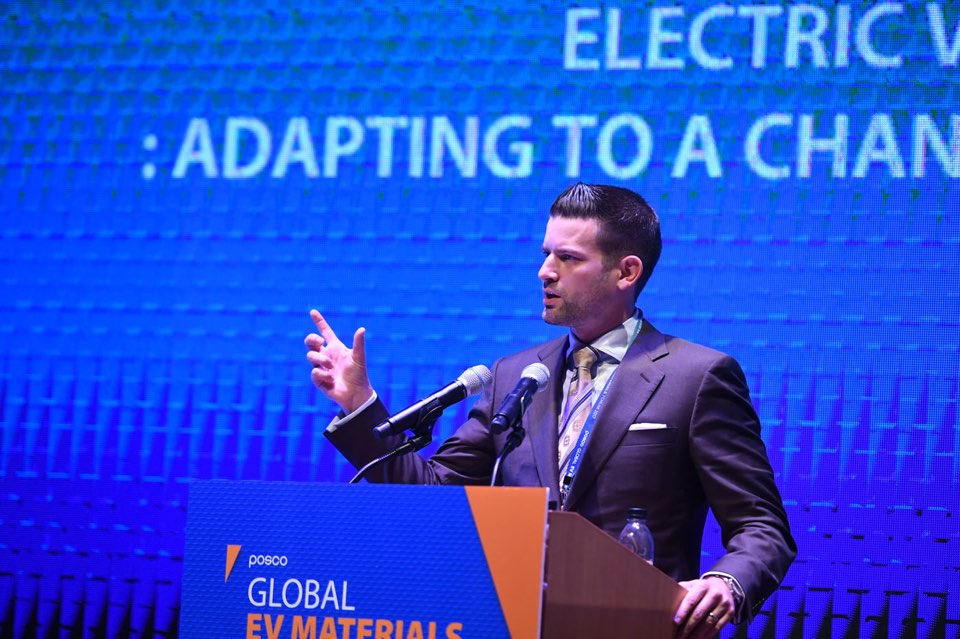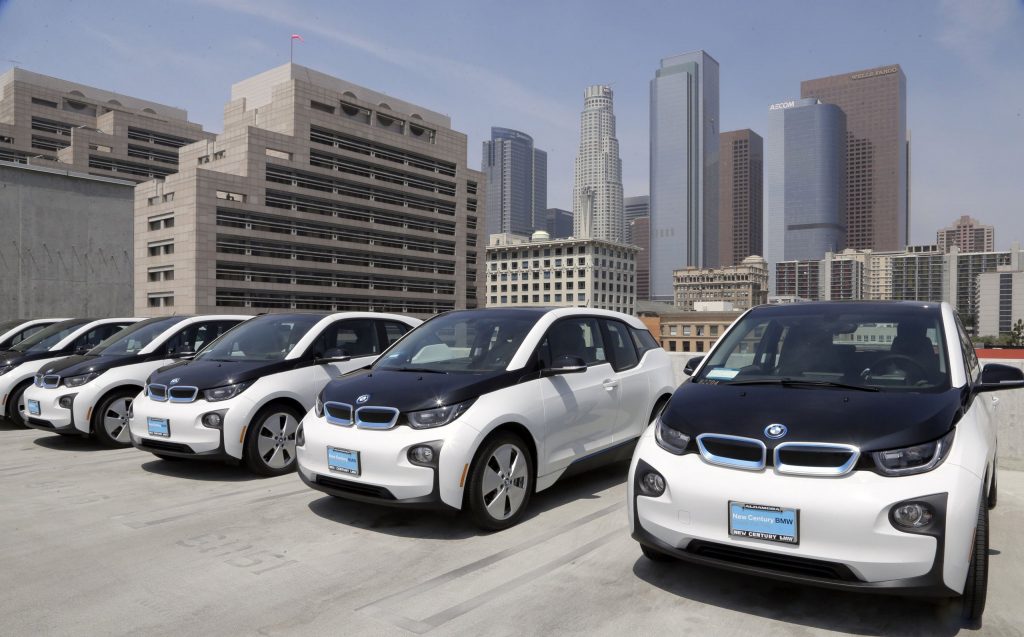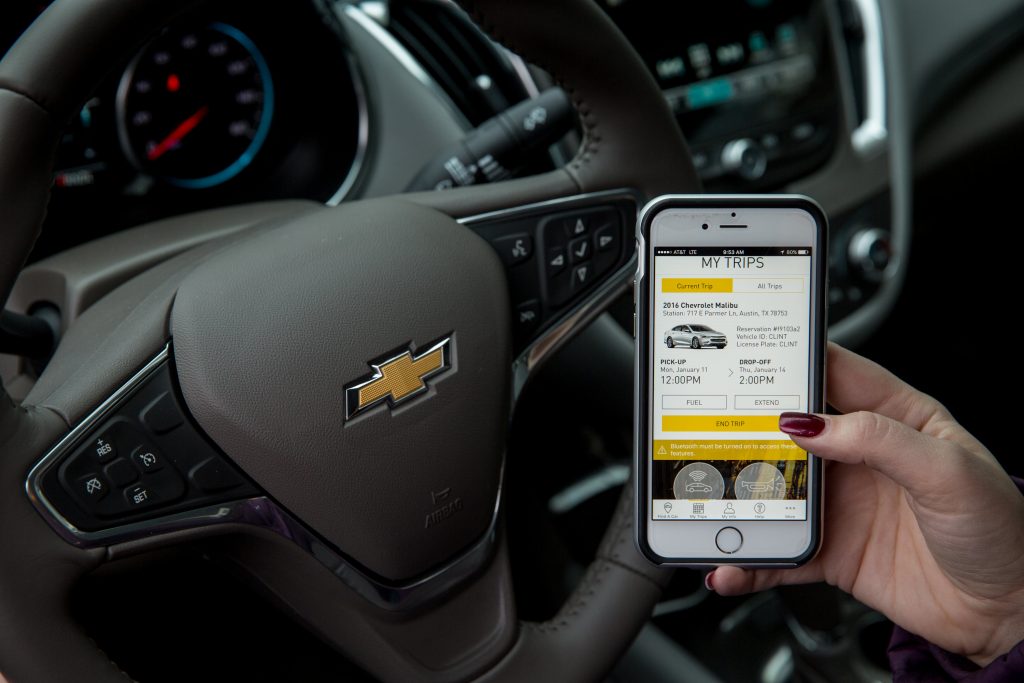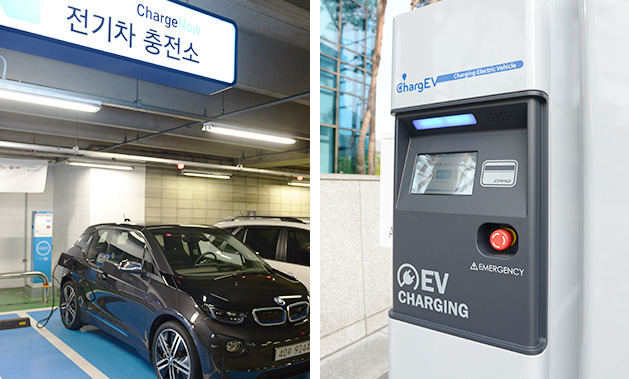From October 30 to November 1, POSCO held the 2017 Global EV Materials Forum at the Songdo POSCO R&D Center. More than 300 clients from over 18 countries attended the event to learn about future trends that will shape the future of the auto industry.

Stephen Zoepf is the executive director at the Center for Automotive Research at Stanford University.
To kick off the forum, Stephen Zoepf, executive director at the Center for Automotive Research at Stanford University gave a presentation called “Electric Vehicles: Adapting to a Changing Marketplace” to share his insights on what future markets will look like and implications for automakers, suppliers as well as consumers.
Here are the key takeaways.
The Future is Going to Look Very Different
According to a report by RethinkX, an independent research group, 6 trillion U.S. passenger miles will be driven in 2030, up 50 percent from 2021. Of those miles, 95 percent will be driven in self-driving, electric and shared vehicles and only 5 percent of those miles will be driven by internal combustion engine (ICE) vehicles.
The report goes on to say that autonomous EVs (A-EV) will make up 60 percent of the U.S vehicle stock, and those vehicles will be part of a shared-mobility service. As more people start to share cars, the overall number of vehicles on U.S. roads will drop from 247 million in 2020 to 44 million in 2030.
SEE ALSO: Going Autonomous: The Transformation of the Transportation Industry
The change is already happening. In 2016, shared-mobility companies such as Uber and Lyft drove 500,000 passengers per day in New York City, which is triple the number of passengers from 2015. Today, more and more automakers like Tesla and GM are also entering the shared-mobility market.

EVs are already becoming prominent in major cities around the world. (Source: Time)
The findings illustrate a future where people drive more miles with fewer cars, which are fueled by electricity, and shared instead of owned. It’s a radical visualization of the future, but one that is driven by economic forces.
By 2021, shared vehicles will be 4 to 10 times cheaper per mile than private vehicles, and American households will save an average of USD 5600 every year by switching to shared EVs from cars fueled by gas, according to RethinkX.
Zoepf shared another report by ARK investment Management which echoes the finding above- in the next ten years, people will drive three times more kilometers using half the number of cars and the number of EVs on the road will increase 10 fold.
What It Means for Car Manufacturers and Suppliers
A shrinking vehicle fleet consisting of mostly EVs can only mean one thing: a major disruption to the current automotive market.
Right now, the average lifecycle of a car in the U.S. is 11 years. However, the majority of a car’s total mileage is driven in its early years. It’s the same for shared vehicles, but they are driven about 80,000- 90,000 km per year, 10 times the distance of privately-owned cars. What this shows is a compression of the vehicle lifespan in its first 3 to 4 years.
These statistics pose critical concerns for automakers.
Will overall vehicle sales decrease in the coming future? According to Zoepf, that’s the wrong question to ask. Instead, automakers should be asking “will I make money?” Automakers have a couple of choices. They can either adapt early on and manufacture EVs and/or A-EVs at a competitive price, or become a shared-mobility provider. Early movers such as Tesla, GM and Volvo are already shifting their business strategies to fit these models.

GM recently launched Maven, a car-sharing service. (Source: The Verge)
Another question to ask is how these trends will affect vehicle design. With shortened vehicle life-cycles, manufacturers can either design cars to last only 3 to 4 years for quick replacements, or opt for the aviation model where the vehicle will be built to last, but the interior parts, such as seats, will be replaced frequently. Whatever route manufactures choose to take, gaining a competitive edge in vehicle and service quality early on will be key.
What Will This Mean for Vehicle Material Suppliers?
If building cars to last is no longer a primary priority, will car makers downgrade their materials? The short answer is not a chance.
Through a customer survey study Zoepf conducted of 60,000 Zipcar customers, he showed that the number one factor when choosing a car is safety. However, there is no one, ideal model or type of car that is preferred in a shared mobility framework. The purpose of the trip determines the type of vehicle, and the success of a shared mobility service provider will depend on the variety of cars it can provide – all with competitive safety ratings.

POSCO ICT already has ChargEV stations set up across Korea. (Source: POSCO ICT)
The supplier’s role will be to continue providing high-quality materials that can boost the safety and cost competitiveness of future vehicles. Steel suppliers have to keep developing lightweight and high-strength steels like POSCO GIGA STEEL, and research new materials that can boost the competitiveness of EVs such as POSCO’s Hyper NO for motor cores, battery materials and POSCO ICT’s EV charging service and infrastructure.
There remain numerous challenges that lie ahead for a greener and safer future with EVs and A-EVs, and it might take longer than experts predict for lawmakers, corporations and consumers to all agree on an optimal mobility model. However, change is already underway and automakers and suppliers alike need to strategize and adapt early on to take advantage of the upcoming opportunities.
For more information on how advanced automotive steel can benefit automakers looking for lightweight and sustainable steel solutions, take a look at our infographic on POSCO GIGA STEEL or read the full report here.
| Stephen Zoepf is the Executive Director of the Center for Automotive Research at Stanford. He has fifteen years of experience in the automotive field, including eight years in engineering and product management roles at BMW and Ford. He recently served as a Post-Doctoral researcher at MIT and on the technical staff of the U.S. Dept. of Transportation. |
Cover photo courtesy of GOV.UK.
- 2017 global ev materials forum
- auto industry
- auto market
- automakers
- automobile
- automotive
- automotive industry
- automotive market
- automotive steel
- autonomous car
- autonomous driving
- autonomous transportation
- car manufacturer
- cars
- Center for Automotive Research
- Center for Automotive Research at Stanford University
- chargeEV
- connected car
- design
- electric
- Electric Vehicle
- EV
- ev battery
- ev material
- ev material forum
- forum
- future
- future cars
- general motors
- GM
- hyper no
- ICE
- lithium
- lithium ion
- POSCO
- POSCO auto steel
- posco automotive
- posco ev forum
- POSCO GIGA STEEL
- posco global ev materials forum
- POSCO ICT
- POSCO R&D
- POSCO R&D Center
- RethinkX
- safety
- self-driving
- service
- shared mobility
- smart cars
- Songdo POSCO
- Stanford University
- Stephen Zoepf
- Tesla
- trends
- vehicle
- vehicle material
- zipcar
